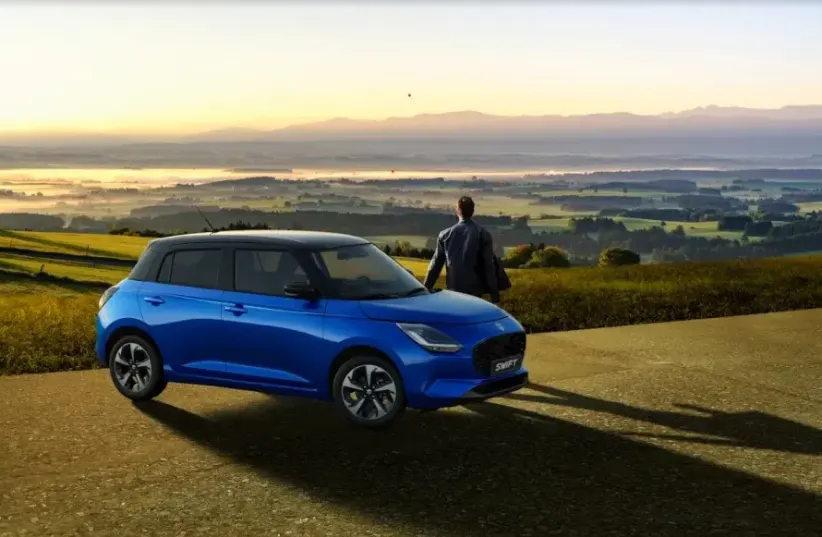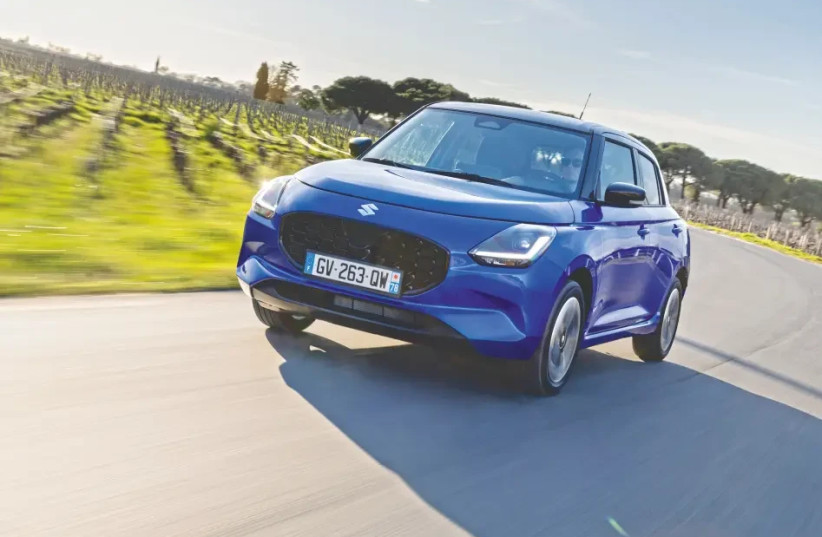In a world marked by technological revolutions, it's reassuring to have stable options like the Suzuki Swift. Electric? At most, a balanced hybrid. Design revolution? You'll easily recognize this model. But how does it drive?
The latest generation of the Swift is the fourth since its introduction in 2004 and its launch in 2005. "How 2005, if my first car was a 1988 Swift?" someone might ask. It turns out that the Swift versions sold in the two decades before were a "badge name" for existing Suzuki models. Clever, right?
After half a day of flights, we meet the Swift face-to-face for the first time at the entrance to the hotel in Bordeaux, where the press launch event and our test drive will start. Bloggers and vloggers with us are already releasing impressions across social media platforms. After such a long journey, first, we'll rest for a night and then hit the road.
Morning, coffee, breakfast, a press briefing with the Suzuki team, and we're ready to go. We head to the fifth floor of the large hotel parking lot. Dozens of Swifts in bold colors await us. The Swifts in the new launch colors - Metallic Pearl Blue and Metallic Cool Yellow - were the first ones grabbed for driving. The warm red and orange tones complement the Swift well. A representative from Suzuki Netherlands, who organized the event, directs me to a Swift in Pearl White with a Mineral Grey Metallic roof. A solid yet elegant combination.
Design: Even before the official photos were released, it was clear that this wasn't an extreme revolution but rather a modern evolution. It's not hard to see that it's a new Suzuki Swift. The wide grille and the stretched headlights slightly resemble the previous generation. Those with keen eyes might notice a resemblance to the Ford Fiesta or even the Focus. The profile with the sunroof covering the front like eyebrows and the hips completing the familiar Swift silhouette from previous editions. Even from behind, it's unmistakable, despite Suzuki's statements about a new trapezoidal shape in the rear view. The large taillights are noticeable, and their light signature is different from the outgoing model.
So what can we expect in Israel? The Swift will be marketed in Israel at one trim level (GLX), and there will be an option to choose between a manual transmission with 5 speeds and a continuous automatic CVT gearbox. Only cars with manual transmissions were present at the launch event. On the one hand, this probably won't be the best-selling version (which is a shame), but on the other hand: hey, at least we'll enjoy the launch driving more. The price for the Israeli consumer is still uncertain, as it is still under negotiation between the importer and the manufacturer. For the attention of residents of Neve Ativ and Majdal Shams, a double-drive version with only a manual gearbox and a higher ground clearance of 1.4 cm will also be marketed abroad. There is currently no plan to import it.
Passenger cabin: The door opens without a key with a press of the button on the door handle. Sitting in the driver's seat and facing the gauges looks familiar and even a bit old-fashioned, some of the tech-savvy among us argue. At the conceptual level, the driver's environment consists of several layers of plastic in different colors, and the main console is oriented towards the driver. The design of the dashboard, the textures of the plastics, and the fabric on the seats exhibit neat design, pleasant colors, but the materials everything is built from look cheap. The plastic on the dashboard is hard to the touch, and fabric pieces on the door trims slightly improve the situation. There is a feeling that everything is well-connected and tightly fitted and will surely last for many years.
In terms of human engineering, operation is expected to be very familiar to those who have driven a Suzuki in the past. Two physical round gauges for speed and RPM are in front of the driver with a digital information screen between them. All buttons, including climate control system buttons and steering wheel controls, including an accessible button to disable lane departure system, remain familiar physical buttons. Everything seems conservative and familiar, without experiments at the expense of ease of operation while driving. A 9-inch touch screen is located in the main console with a too thick black frame finish. The prominent change is the touch buttons for operating the multimedia system below the main screen. The system supports smartphone connectivity, and during driving, Android Auto worked excellently wirelessly via the built-in Wi-Fi in the car.
With a wheelbase of 2.45 meters, the Swift offers more spacious passenger space than the numbers suggest: the front passenger space is excellent, and the combination of bright colors gives a feeling of space. The front seats are comfortable, and as expected, they have manual adjustment only. Further investigation reveals that the lower back support is good, but the side support is inadequate in turns. The Swift doesn't pamper rear passengers: there's no central armrest, and there's no vanity lighting in the cheap sun visors.
Since Suzuki declared at the press briefing that this is mainly a car for two people, concerns arose about the state of affairs behind. The rear seat entry is large and allows smooth entry even for tall people. Contrary to that initial concern, the Swift offers excellent living space for two adults in the back seat. The relatively flat floor and the headroom are suitable for passengers up to 1.8 meters tall. The downside to sitting in the rear seat is mainly in terms of equipment: there are no pockets behind the front seats and no air vents. There are only cup holders in the door trims and later on, in the console between the front seats. I assume on AliExpress they will celebrate here with aftermarket products like an armrest that looks original.
Safety: The specifications of the active safety systems are definitely respectable and give it a score of 6 out of 8 in the Ministry of Transport rating. The calibration of the systems is not too annoying or intrusive, except for the speed sign recognition system, which is efficient but irritating. With the strict European speed enforcement, we managed to cope with that too. The lane departure system, which tends to be annoying, also warns in a polite manner.
Performance and Engine: Beneath the engine cover lies a new 1.2-liter 3-cylinder unit that comes in two versions: regular gasoline and mild hybrid. The hybrid version will be imported to the country, and that's the one we encountered at the launch event. On paper, the gasoline engine develops 82 horsepower at 5,700 rpm and a torque of 11 kgm at 4,500 rpm. The hybrid system adds about 3 horsepower to the "celebration."
With numbers like these, no one expects the Swift to be a road-eating machine. Press the button to start, and you hear the engine come to life. As expected from three-cylinder engines, when you open the engine cover, you can see the engine shaking at idle, but the vibration doesn't transmit to the passenger compartment.
Pressing the clutch, shifting into first gear, and hitting the road, even during the ascent through five levels of the parking lot, you can appreciate the smooth operation of the gear lever and the clutch, and the small engine's growl. The launch event took place in the wine region of France. The route included calm driving between pastoral villages, sleepy vineyards, and farms, to the delight of French enthusiasts in the audience, serving as wineries for tastings and wine sales.
On urban roads, the Swift's modest power unit allows for reasonable accelerations with decent power availability at low rpm. After getting used to small, turbocharged engines that could feed their owners with bitterness in terms of reliability, there's a different dance here. Even though you can't drive on electricity alone, the electric motor's boost replaces the turbo for power availability. Combined with a low curb weight, an efficient power unit, and easy gear operation, the Swift delivers a joyful feeling as a supermini should.
On the way back to Bordeaux, we take the A630 for a few kilometers, even though it wasn't part of the planned route. Noise isolation at urban speeds is good, with only a few road noises penetrating the passenger compartment. Despite the relatively soft tuning that works excellently on urban roads, providing good damping and insulation, it seems challenged on the cursed Highway 444 in the Holy Land.
Fuel Consumption: The hybrid propulsion unit proved itself with an average consumption of 20 km per liter in smooth mixed driving. When we shifted to a more intensive driving mode, consumption rose to 18 km per liter. With such figures, even with a modest fuel tank capacity of 37 liters, the Swift can easily achieve a range of 600-700 kilometers.
Road Behavior: In the past, the capabilities of supermini models were also measured in dynamic aspects, with the same vague concept called "driving pleasure." Suzuki declares that the Swift is supposed to offer a driving experience, something they call "Waku Waku" in Japanese, although there are no plans for a GTI version as in the past. Despite being finely tuned for comfort, the chassis itself manages to convey information to the driver and even allows some weight transfer play with the throttle. Only the steering with its imprecise feedback and dead zone in the center spoils the good impression made by the chassis.
Comfort: Within the villages, the Swift absorbs urban road irregularities with ease, thanks to successful suspension tuning, which doesn't overdo blessings, and thanks to the fuel-efficient Yokohama Blue Earth tires, reasonably sized at 185/55R16. The bottom line: the fourth generation of the Swift represents an improvement over the previous generation in many respects: the smooth and efficient power unit, active safety systems, good ride quality, and interior design. On the downside, one can mention the saving on equipment and material quality. The hidden variable is the performance of the new continuously variable transmission and its integration with the hybrid propulsion unit. For a full and comprehensive review, we'll have to wait for the Swift's arrival in Israel in the coming June. In the meantime, it seems that traditional Suzuki customers and perhaps even new customers looking to play it safe have something to look forward to.
Daniel Skali, who was a Suzuki guest in France, participated in preparing the content.


